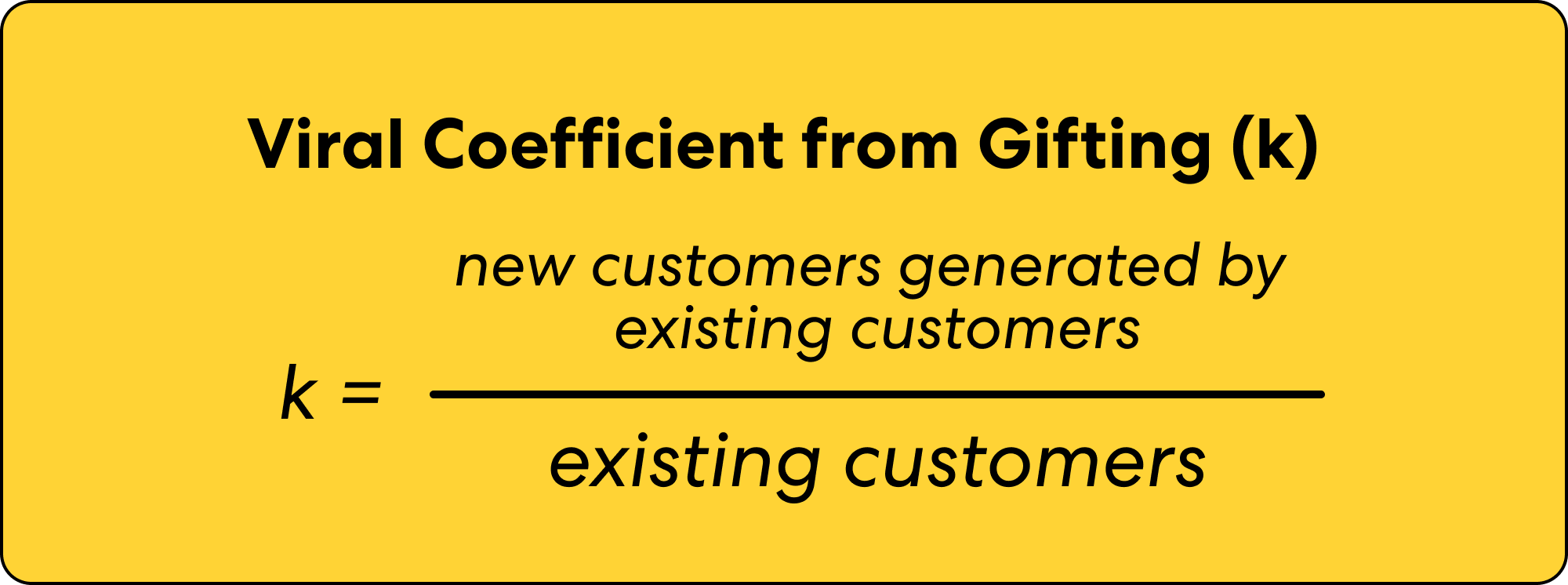Not sure if ramping up your gift channel is the right move for your brand?
We get it — it can be scary to try new things, especially in such uncharted territory.
Easily accessible and convenient self-service gifting is a relatively new opportunity for ecommerce brands, and it’s tough to justify the spend on new tools if you simply don’t know how a new channel will perform.
While we can’t predict the future (would be sick, though), we can give you an idea around how to determine your gift channel’s return on investment (ROI) and gain clarity around if this channel is a good fit for your company.
Let’s dig in!
The Metrics to Track to Determine Your Gift Channel’s ROI
You may be thinking, “Gee, can’t I just determine the ROI of gifting like any other ecommerce channel?” And the short answer is no.
Let’s look at how you’d typically determine the ROI for your whole store.
You’d first identify your net profit (revenue earned minus costs), then divide it by the total costs. Then you’d multiply that by 100 to get your ROI percentage.

That’s a pretty cut-and-dry formula. But the reason that that formula isn’t as simply applied to your gifting channel is because there are a few more factors to consider beyond revenue from gifts sold and the costs of those products and gifting tech.
Gift Recipients
Unlike a 1:1 transaction where your DTC customer comes in, buys a product, and logs out — leaving you with a clean formula — gifts inherently include gift recipients. And with a tool like Zest, those recipients have the opportunity to opt into your brand’s marketing where you engage and nurture those recipients into customers, dramatically lowering your customer acquisition costs.
So, how much is a lower gift-driven CAC saving your bottom line? Make sure to account for those cost savings when looking holistically at your gifting channel.
Gift Adoption Rate
With Zest in your tech stack, you unlock gifting features for practically any kind of gifting, including consumer, corporate, event, and concierge. When determining if gifting is a fit for your brand, make sure to look at the percent of total orders that include any gifting feature, like digital gift messages, multiship orders, e-gifts, and more.
Looking at this percentage will help you determine if gifting in any capacity is a fit for your specific audience.
Gift Average Order Value
When it comes to buying gifts for friends and family, people tend to spend more than they would if they were simply buying for themselves. (People are especially more likely to spend more if the gifting experience is fully optimized and easy to use.)
For example, Levain Bakery saw gift orders placed through Zest had an AOV of nearly 20% more than gifts ordered through less optimized paths. When assessing ROI, it’s important to look at this metric and assess a higher (or lower) AOV and what that could look like for your bottom line at scale (say, like, when it’s peak holiday gifting season — how much would a 20% higher AOV net you?).
Gifting Frequency Rate
Investing in online gifting tools today makes you an early adopter in this category. Gifting is a booming industry, but most brands still see gifting tech as a nice-to-have (or they don’t even know it exists yet). In essence, having a customer experience optimized for gifting is a major win for your brand as it’s still a unique selling point that earns repeat business.
For example, if you launch a self-service corporate gifting storefront, B2B clients are 100% going to choose your store over competitors every time if it means they can buy, personalize, and send 150 gifts in minutes versus weeks. These are high-value, high-frequency orders that would otherwise go to your competition.
If your Shopify checkout is fully optimized with custom gift notes and the power to send gifts to many people in one transaction, you’re instantly going to be the go-to gifting destination for your customers.
It’s important to track who your repeat gifters are, and you can even take this a step further and compare their purchase frequency of gifts versus non-gifts to determine what’s driving their loyalty.
Administrative Time Saved
Historically, gifting has been a largely untouched experience because it’s tedious, time-consuming, easy to mess up, and difficult to scale. Before tools like Zest, gifting has been a fully hands-on experience, which means extra labor, processing times, and expenses.
With Zest, your store can fully automate large corporate gift orders, process high-touch concierge orders in one management tool, and streamline the consumer gifting process natively in your checkout. It’s hours upon hours saved with every gift order, which is nothing to ignore in your ROI calculation.
Viral Coefficient from Gifting
Gifting is a unique channel in that it creates an organic flywheel of growth.
Each gift sent has at least one recipient. For multiship orders or corporate gifts, those recipient lists only go up and can reach into the hundreds or thousands.
That means that with one (albeit large) purchase, many, many more people are about to be exposed to your brand as they receive, use, and enjoy your products (all without you dropping a penny on extra marketing to reach that engaged audience).
Gift recipients are your hottest leads yet, and each recipient has the potential to become your best new customer. And once they’re a customer, they may start sending gifts of their own, thus perpetuating this awesome money-making flywheel.
This metric looks at the number of customers generated from gifting activities divided by the number of existing customers who participated in gifting within the same time period.

By tracking new customers attributable to gifting by matching recipient details with new customers, this metric is crucial in determining the true scope of gifting’s ROI.
Steps to Take to Boost Your Gift Channel’s ROI
If you’re just getting into gifting and not seeing a tremendous blast-off into money-making glory, remember that this new channel’s fate is in your hands. Consumers are used to ecommerce stores either 1) not offering any type of gifting capability, or 2) offering just corporate gifting via a contact form link buried in the footer.
The average shopper is used to making do and trudging through gifting agony, so it’s on you to come up with a plan to drive awareness of your store’s gifting capabilities while making it super accessible.
This could look like:
- More emails specifically about gifting and offering gifting discounts or incentives to your existing customer base.
- Placing CTAs to gifting in high-vis locations, like product description pages, pop-ups, your cart drawer, and in the checkout.
- Publishing a gifting-specific landing page that highlights all the ways your shoppers can easily gift on your site while answering any FAQs that could crop up.
- Creating influencer or UGC campaigns that spotlight how easy it is to send gifts and get Christmas shopping done thanks to the tools on your website!
In short, if no one knows about your sweet gifting features, no one will use them. To ensure you squeeze the most ROI out of this lucrative powerhouse, it’s up to you to spread the word.

Making the Final Decision About Gifting
In a dream world, every brand would be slinging gifts left and right. Unfortunately, that’s not always the case. Like with anything else in the world of ecommerce, not every channel is the best fit for every online brand.
Perhaps your audience isn’t looking for gifts, or maybe your product is less giftable than you imagined. Whatever the reason, if you’re not seeing an ROI from your gifting channel that meets or exceeds your expectations after taking in all of the KPIs above, it’s OK to come to the conclusion that it’s not the best channel for you at this time.
The key is that you looked at the right numbers, assessed the data, and made an informed decision. And in our book, that’s still a major win.
.png)


.png)





